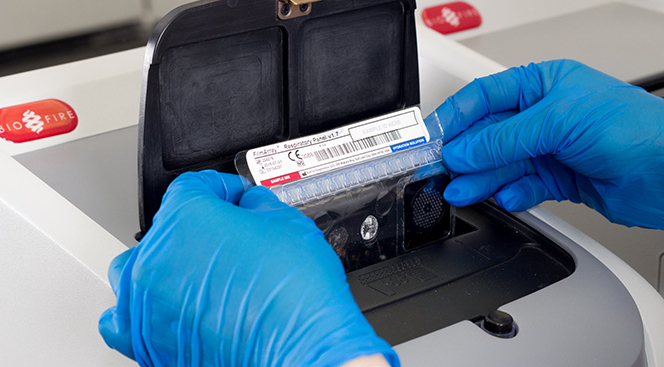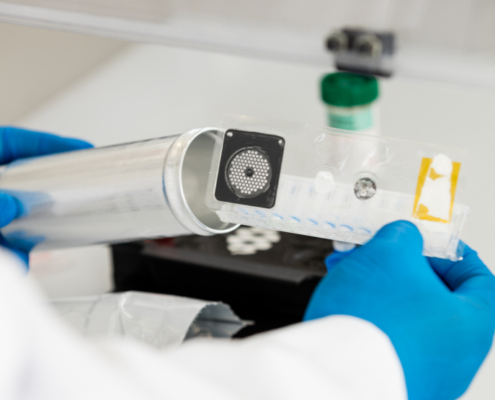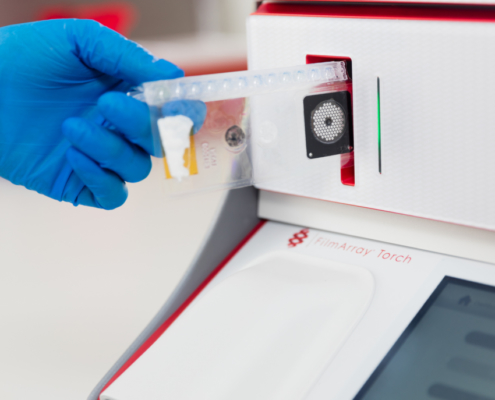How We Achieved the BioFire “Big 5”
The first 5 panels for the BioFire® FilmArray® System were specifically designed to target syndromes that meet three important criteria.
Most infections present as a syndrome, with signs and symptoms that are common to many pathogens. Traditional diagnostic methods often rely on guesswork—ordering a targeted test for the most probable cause of illness, waiting hours or even days for results, and repeating the process until a pathogen is positively identified. The syndromic approach, however, empowers healthcare professionals to skip this guesswork.
When we entered the field of infectious disease diagnostics, we made a goal to innovate what we called the BioFire “Big 5”—five cutting-edge syndromic testing solutions for the most common and most dangerous infectious diseases. We officially achieved this landmark with the launch of our fifth panel in late 2018.
Each of our five panels tests for a broad spectrum of clinically relevant targets:
- The BioFire® FilmArray® Respiratory Panels
- The BioFire® FilmArray® Blood Culture Identification (BCID) Panel
- The BioFire® FilmArray® Gastrointestinal (GI) Panel
- The BioFire® FilmArray® Meningitis/Encephalitis (ME) Panel
- The BioFire® FilmArray® Pneumonia Panel
We knew from the start that our molecular syndromic testing technology had enormous potential—and we knew that it would be best utilized for syndromes that meet three important criteria.
When a Syndrome Has Many Potential Causes.
With over 100 targets across 5 panels, the BioFire System offers the broadest menu of infectious disease pathogens on the market. A common syndrome that has many potential causes is the ideal candidate for a comprehensive syndromic test.
Respiratory infections affect everyone, and they can be caused by a large number of pathogens. During respiratory season, a targeted flu test risks missing the real cause of illness. The BioFire® FilmArray® Respiratory Panel 2 detects and identifies 21 targets, providing definitive results that can improve patient management year-round.
When Identifying the Cause of Infection Informs Treatment.
The best treatment for an infection can depend on what caused it. A syndrome that requires pathogen-specific treatment should be diagnosed with a pathogen-specific syndromic test.
Distinguishing bacterial from viral meningitis is difficult because patients tend to present with identical, flu-like symptoms. Viral meningitis is more common, but bacterial meningitis is more deadly. By rapidly testing for the most common causes of central nervous system infections, the BioFire ME Panel can inform targeted treatment and promote antimicrobial stewardship.
When Time-to-Result is Critical.
Some infections can quickly become life-threatening, making early pathogen identification essential.
A syndrome for which time-to-result is critical demands a syndromic test that doesn’t sacrifice speed for specificity (or vice versa.)
The longer a bloodstream infection goes untreated, the more likely it is to become fatal. Decreasing sample-to-answer turnaround time can improve septic patient survival—that’s why we engineered the BioFire BCID Panel to test for 27 targets in about one hour.
What’s Next for BioFire?
By achieving the BioFire “Big 5” we successfully met our starting goal: to innovate five syndromic panels that help solve some of the most pressing dilemmas in infectious disease diagnostics. And that’s just the beginning!
Every day, we are actively working to improve our existing products and to create brand-new products. Get in touch with us to learn more about the latest in syndromic infectious disease testing from BioFire.






